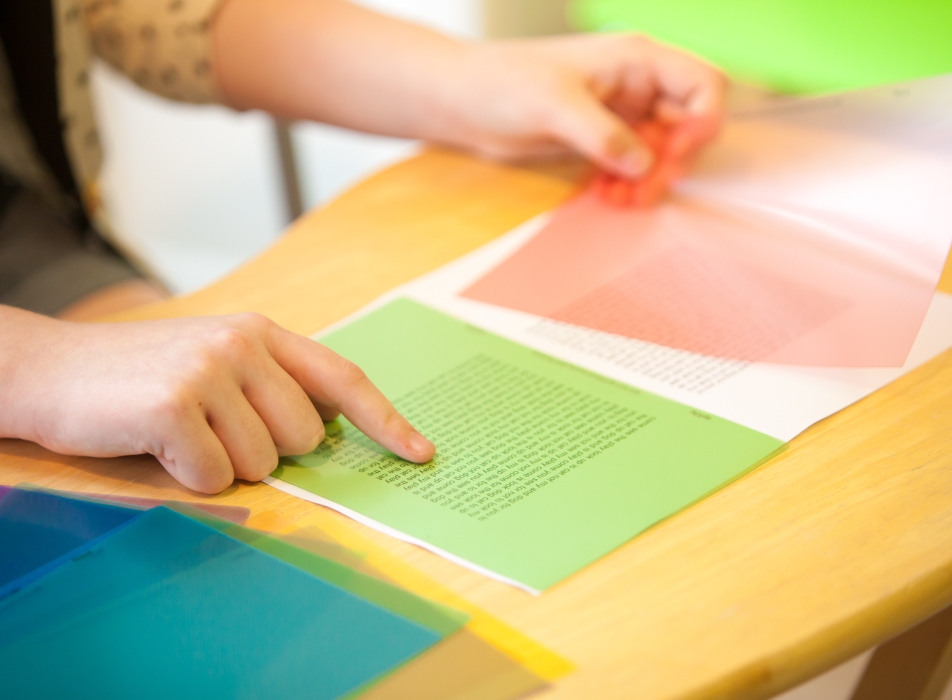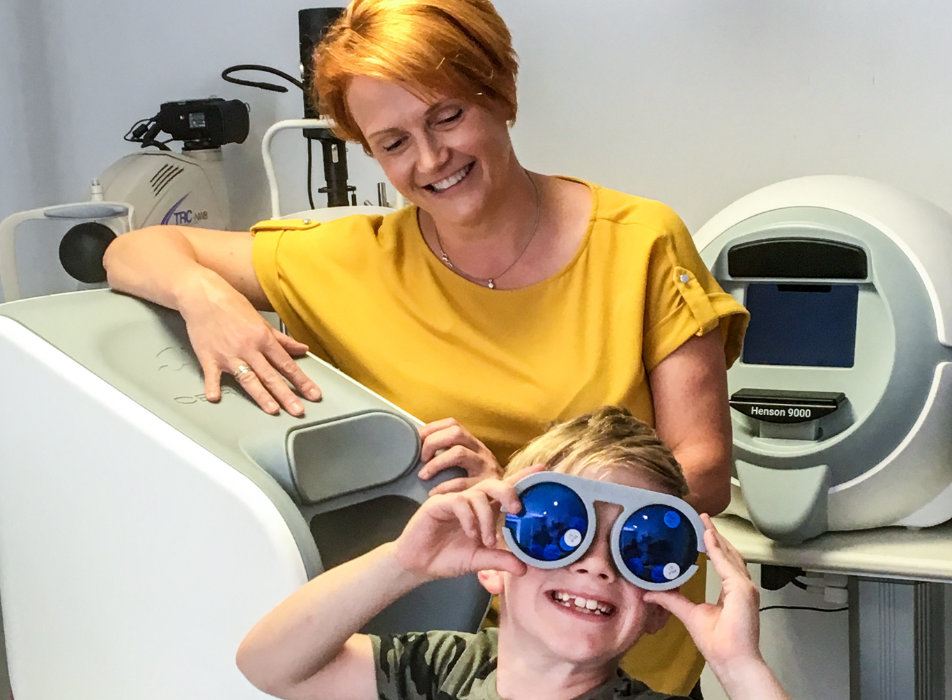Vision & Reading Clinic
Find out how we can help improve your child's reading abilityVisual problems in children and Adults
Many children struggle with their reading, which could be due to uncorrected sight, poor eye coordination or difficulties viewing pages of text – visual stress, where the words become hard to see clearly, distorted or wobbly. This condition also affects some adults.

An appointment with Dr Caroline Wilson, our dedicated specialist Children’s Optometrist can help determine what the issues may be. In some cases, reading difficulties can be caused by vision problems such as long-sightedness, astigmatism or problems coordinating the eyes. This can be identified at an initial assessment.
It might be that the patient is struggling with Visual Stress – sometimes known as Meares-Irlen Syndrome. We have found that coloured overlays can help reduce the condition and a simple computer-based test can identify whether a particular coloured overlay can help with the condition. A further in-depth analysis can have even better results, using our intuitive Colorimeter, which chooses the perfect colour from thousands of combinations. This is made up into a pair of spectacles, which can in many cases, can improving reading ability. Your child then has the freedom to read books, use their computer and view the whiteboard.
Visual Stress
Many people struggle to read and often, it is not due to poor eyesight. Visual stress is a term used to describe visual discomfort and perceptual distortions in printed text
Visual Stress affects many people in differing degrees of severity. It is estimated to be suffered by around 40% of poor readers and 20% of the general population.
It can affect children and hinder their reading development.
Dyslexia is a Specific Learning Difficulty, affecting reading ability. Dyslexia can only be diagnosed by an appropriate educational professional. Our Optometrists do not diagnose or treat Dyslexia. However, we can use coloured overlays and lenses to reduce the symptoms of Visual Stress, which can make reading more comfortable.
Coloured lenses can also be used to help control migraine.
Visual Stress
What is Visual Stress?
- Visual discomfort and perceptual distortions in printed text
- Symptoms can occur, despite normal vision
- Many children think what they see is normal
- Estimated to be present in
- 40% of dyslexic individuals
- 20% of the general population
- 5% of the population to a severe degree
Signs of Visual Stress
- moving closer to or away from the page
- becoming restless when reading
- using finger as a marker
- skipping words and lines
- rubbing eyes and blinking excessively
- low self esteem
Migraine
- Migraine is often associated with a sensitivity to glare, and some patients are photophobic during an attack. Glare sensitivity may occur in response to bright lights and bold geometric patterns, particularly those of stripes
- This sensitivity is associated with a strong response in the visual cortex of the brain and may be reduced by using Precision Tinted Lenses.
- Precision Tinted Lenses may also prevent migraine attacks. More often they enable patients to continue their daily activities despite attacks, and to cope in uncomfortable environments.
Is Visual Stress the same as Dyslexia?
- Dyslexia is a term used to refer to a number of complex specific learning difficulties that often also include problems with reading and spelling.
- Visual Stress often runs concurrently with dyslexia, and it has been established that there is a far greater propensity amongst the dyslexic population to suffer from Visual Stress.
- Removal of Visual Stress in dyslexic children allows exposure to print for longer
Symptoms of Visual Stress
- movement of print
- fading of print
- letters changing shape or size
- letters fading or becoming darker
- patterns appearing, sometimes describes as “worms” or “rivers” running through print
- illusions of colour – blobs of colour on the page or colours surrounding letters or words
- rapid tiring
- headache or eyestrain
Other neurological conditions
Other neurological conditions have been shown to benefit from the use of Precision Tinted Lenses. Research has shown that reading can, in some cases, improve significantly in Autistic spectrum individuals with the use of a precision colour. Acquired brain injury sufferers have also, anecdotally, shown benefits with a chosen colour. This work is ongoing.
- Autism
- Epilepsy
- Closed Head Injuries
- Other conditions which have an effect on the visual cortex
The four stages of visual assessment
1: Initial assessment - a full eye examination including binocular tests to rule out any ocular condition which can be corrected with prescription spectacles and/or eye exercises.
2: Overlay assessment - similar to the overlays used in schools, but more comprehensive. A colour is chosen with the help of a computer system from a range of 15 colours. The child is given that coloured overlay to help with reading.
3: Colorimetry - if the child is showing success with their coloured overlay, the next step is for them to have an assessment using our intuitive Colorimeter, which chooses from tens of thousands of colours to find the exact colour match to suit your child. Spectacles (which can include a prescription as well) are made up to the exact colour
4: Regular re-assessment - we recommend a regular recheck - annually to see how your child is getting along and whether a retest may improve effectiveness.
Initial Visual Assessment
We recommend an extended eye examination first. A full refraction will identify whether the child is in need of visual correction. This is corrected first, before going any further.
We recommend a binocular vision check as even a small disparity in coordination between the eyes can affect binocular stability.
We then carry out a pattern glare test to screen for Visual Stress symptoms.
Overlay assessment
A rate of reading test computer analysis is used to determine the child’s unaided reading ability. A computer program is then used the find the basic colour which alleviates Visual Stress symptoms. The child is then given that chosen coloured overlay and retries the rate of reading test to assess improvement in reading.
Coloured overlays are found to be effective in many children, but the effectiveness may be improved using our advanced Colorimeter.
Colorimetry and spectacles
Coloured overlays are useful when reading from a book, there are only a limited range of colours.
A much better result is achieved with an in-depth analysis using Colorimetry. Research has shown that a better result can be achieved by more accurately pinpointing the most effective colour from the thousands of tints, shades and hues.
Precision tinted glasses can then made which are more convenient when copying from the board or from a book, or for those who are particularly light sensitive and may develop headaches and eye strain when attempting to read.
Monitoring and reassessment
We recommend a regular recheck – annually to see how your child is getting along and whether a retest may improve effectiveness.
Does Colorimetry work?
Some doubt has been cast on the effect of the use of colour to reduce the symptoms of visual stress and Migraine. There is no conclusive link yet and further research is needed. What is clear to us as practicing Optometrists is that colour does in many cases have an effect in reducing Visual Stress.
Download our Colorimetry Brochure here with a helpful test you can try at home with your child.
The Association of Optometrists (AOP) has some interesting further reading here.
You can download the Association of Optometrists (AOP) brochure on the subject here.
Many of our parents have seen the effect on our young patient’s lives – much improved rate of reading and children leaping ahead in class, once they have their overlay or new coloured spectacles.
Colorimetry to relieve Migraine
Colorimetry has been shown to help alleviate the onset of Migraine in acute sufferers. Going through almost the same process, with reading assessment, Colorimetry is used to determine which colour best relieves the symptoms.
Supporting The Principle Trust children’s charity
Seeing just what a difference Colorimetry can make to a child’s life, we have decided to team up with a local charity who also make a difference to the lives of children in our area.
We are proud to support Skipton-based charity The Principle Trust, who provide free respite holidays to children who are underprivileged, disadvantaged, disabled, have life-limiting conditions, or who have experienced poverty, trauma or abuse.
We will make a donation to The Principle Trust for each Colorimetry assessment we undertake.








